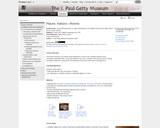
Students will practice using vocabulary associated with a room and objects in the room.
- Subject:
- Arts Education
- Visual Arts
- Material Type:
- Lesson Plan
- Provider:
- J. Paul Getty Trust
- Author:
- J. Paul Getty Museum Education Staff
- Date Added:
- 02/26/2019

Students will practice using vocabulary associated with a room and objects in the room.
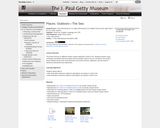
Students will practice using vocabulary associated with the weather and how people react to the sea.
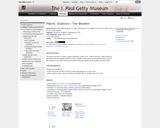
Students will practice using vocabulary associated with the weather and time of day.
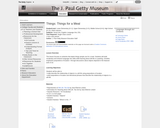
Students will build vocabulary and enhance language arts skills while learning about still life in a painting. Activities emphasize prepositions of location—through discussions about objects depicted in the featured work of art.
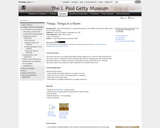
Students will build vocabulary and enhance language arts skills while learning about decorative arts.
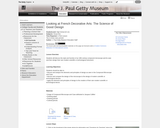
Students will discuss the style and function of an 18th-century compound microscope and its case and then design their own modern scientific or technological instrument. Students should be able to discuss and analyze the elements and principles of design as seen in the Compound Microscope and Case; discuss and compare the design of the microscope to the design of modern scientific or technological devices; and apply the elements and principles of design to the creation of their own modern scientific or technological device.

Students will view Pistoletto's "Mirror Architecture" and consider why an artist might choose a fractured mirror to create a work of art; how the surroundings and the viewer interact with the sculpture; and how our perceptions of the piece might change in different locations. Students will write a story with the mirror as the central subject. Students will also write a short story which explores the symbolism of mirrors.

Students will explore artists' choices of nontraditional art materials; explore how artists use different materials to engage space and will consider the role of the viewer in that process.

Students will be introduced to the notion of ephemeral and site-specific art and will consider the role of the photo-documentation of these works; explore works that challenge traditional notions of where art should be displayed; be introduced to artists' strategies of institutional critique.

Students will consider artists' choices related to materials, line, color, and scale; consider artists' motivations for using repeated forms; compare and contrast industrially fabricated works of art with those made by hand.

The five lessons that comprise this guide may be used sequentially or as independent units. An introduction to the key principles of each lesson is followed by a close examination of the works, including historical context and information on the artist. Discussion questions based on the images lead students through formal analysis of the artworks and seek to create connections between information and visual evidence. The activities that conclude each lesson encourage students to synthesize what they have learned about the works, and carry the lessons into the broader curriculum or relate it to skills students are practicing in the classroom.
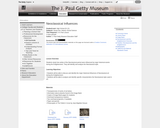
Students study how artists of the Neoclassical period were influenced by major historical events during the Enlightenment. They will identify and analyze the Neoclassical style.

Students will consider the challenges of representing identity visually; consider text and elements of popular culture in an image; continue to consider the role of drawing as a political medium.

Students will consider portraiture as a means of political expression; discuss the elements of a portrait that contribute to its meaning, such as expression, pose, costume, and background; consider the effectiveness of drawing as a form of political expression.

Students will compare and contrast two paintings; understand the term modern as used in an historical and art historical context; become familiar with the terms foreground, middle ground, and background.
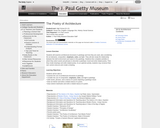
Students will examine architectural structures in paintings and how they are used, also considering the art elements, composition, emphasis, color, and light. Students will be able to examine the use of architectural structures in paintings; consider the use of composition, emphasis, color, and light in paintings; write words, phrases, and a stanza of a poem depicting a painting's mood; draw an interior and write a related stanza of a poem; and draw exterior landmarks and write a related stanza of a poem.

Students will learn about design issues including sustainability, safety, and use; explore how architects are using green technologies in today's buildings; investigate how the built environment affects the natural environment; investigate how the natural environment affects the built environment.

Students will become familiar with the industrial developments of the twentieth century and how they affected architecture and society; explore the development of urban environments; compare and contrast graphics and drawings; create works of art that document their neighborhoods from their own perspectives; learn the terms utopian and conceptual.

Students will explore the inventions and material innovations that made the construction of skyscrapers possible; become familiar with the roles of architects and engineers; make connections between architecture and history; learn the terms ziggurat and cladding.
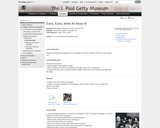
Students will be able to visually analyze a photographic image; write a headline and a story to accompany an image chosen from a newspaper; and compare what they see in a photojournalistic image to what they read in the story accompanying the image.